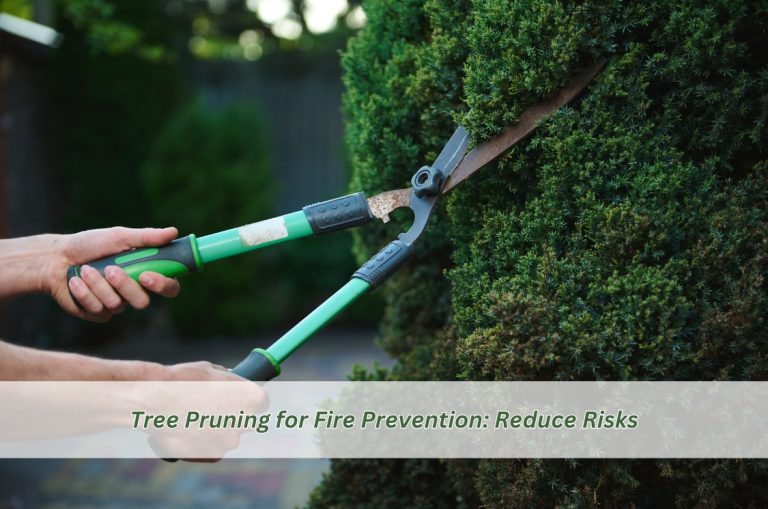For some areas, bushfire season is always on homeowners’ minds, especially for those who live in rural and semi-rural areas. The speed at which flames can spread and the potential for catastrophic property loss is frightening. Although no silver bullet exists to obliterate risk, this step will vastly improve your odds of keeping your home safe.
On the other hand, tree pruning for tree health and minimising fire spread potential is a critical but often overlooked approach to reducing bushfire risk. We’ll examine how knowledge of fire behaviour can be applied to your pruning practices, describe how working with a professional arborist can shortcut your learning, and explore why deadwood removal is essential to creating your fire-resistant landscape.
Pro pruning for fire safety
Proper pruning of trees to reduce fire risk is not just about lopping off branch tips. It is a science-based on appreciating fire behaviour and tree physiology. The objective is to create a landscape that reduces fuel load and breaks the road of a fire.
This involves selectively trimming specific branches depending on the tree’s type, age, and location. It creates space between the tree canopy, the ground, and the trees. This lowering of what we call the “fuel ladder” is key since so many fires spread when they jump from vegetation near the ground to the canopies of trees.
- Crown lifting: Removing low branches creates greater vertical clearance from the ground.
- Thinning involves reducing the density of the canopy to improve airflow and reduce fire heat.
- Selective pruning: Trimming out dead, diseased or weak branches that serve as kindling.
- Creating spacing: This approach involves pruning trees to ensure a space between their canopies so fire cannot quickly jump from tree to tree.
- Regular maintenance: Regular trimming is crucial to keeping the landscape fire-resistant.
Fire behaviour and tree risk understanding
Knowledge of fire behaviour is essential for proper total fire prevention. Fires spread via radiant heat, convection and direct flame contact. Trees are an integral part of this process. Heavy canopy can retain heat and create a “chimney effect,” which fuels the spread of flames. A fire needs dry, dead branches and accumulated leaf litter to catch fire and grow.
Some tree types are also more flammable than others. For example, though iconic in the Australian landscape, eucalypts are characterised by being high in oils, rendering them incredibly flammable.
- Fuel load: The visible amount of flammable material in an area.
- Fuel ladder: The vegetation that allows a fire to ascend from the ground into the tree canopy.
- Radiant heat: A fire gives off heat, which can cause combustibles nearby to catch fire.
- Convection: Transfer of heat through the movement of air.
- Flame contact – When flame is in contact with a flammable material.
Fire-damping pruning practices
Specialised pruning practices need to be used to the absolute minimum fire risk. Crown lifting — removing the lower branches of a tree — is one way to create distance between the ground and the canopy. This prevents ground fires from lighting the tree.
Thinning the canopy makes it less dense, allowing air to flow better and decreasing fire intensity. For the vast majority, selective pruning helps remove dead, diseased and weak branches, which are more likely to go up in flames.
- Crown lift: The removal of lower branches to create vertical separation.
- Thinning: Decreasing canopy density for better airflow.
- Prune selectively: Abolish dead, diseased and weak limbs.
- Creating fire breaks: Sometimes, pruning and clearing trees can create fire breaks that disrupt the path of fire.
- One realistic way to stay protected: Defensible space.
Advantages of expert pruning of trees
Homeowners can do some essential tree pruning, but engaging a qualified arborist is highly recommended, especially for fire prevention. Certified arborists possess the knowledge to evaluate the unique fire risk of your property and recommend specific pruning solutions.
They are versed in tree biology and can do pruning techniques that boost tree vigour and lessen fire peril. They also have the gear and training to remove big branches and trees safely.
- Professional advice: Arborists can assess your fire risk and recommend pruning.
- Specialist techniques: They are familiar with several methods, such as crown pollard, deadwooding, and tree thinning, that encourage plant, fruit and overall tree health whilst reducing fire risk.
- Safety: Arborists have the tools and experience to do tree work safely.
- Regulation: They are familiar with local laws that pertain to tree removal and cutting.
They can do it more quickly and efficiently.
Removing deadwood: Clearing out the fuel
Deadwood is a significant fire hazard, including dead branches, standing dead trees (or snags), and fallen logs. It dries quickly and burns easily, giving a fire plenty of fuel to grow. Cleaning deadwood regularly can help prevent fires. This includes pruning dead branches from live trees and clearing away fallen debris and other dead vegetation from the soil.
- Regular inspections: Inspect trees often for dead or dying limbs.
- Trimming: Cut down dying branches ASAP so they don’t become kindling.
- Stump removal: Remove dead tree stumps that can hold fire.
- Debris clearing: Regularly remove fallen leaves, twigs, and other dead vegetation around trees
- Establishing a clean zone: Keep an area around your home clear of combustible materials.
Our homes are protected when we deal with such problems through tree pruning.
Conclusion: Safeguarding homes with tree pruning
Bushfire-prone areas should always be carefully managed for safety, including tree pruning for fire prevention. While these trees are no longer an extreme fire hazard, homeowners can ensure they remain so by learning about fire behaviour, pruning techniques, and regularly removing deadwood. Although professionals are the best option for most large-scale projects, even essential pruning and maintenance can go a long way.
Note: Preventive actions are paramount to securing your household and neighbourhood from the smouldering hazards of bushfires. In February 2025, with the likelihood that dry conditions may occur in some areas, these preventive measures are more critical than ever. So don’t wait until it’s too late. Make tree pruning a priority and build a fire-resistant landscape now. It is an investment in the safety and security of your home and family.

